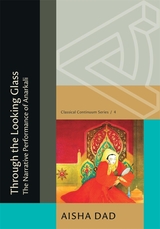


Anarkali, an Orientalized persona assigned to the harem of the Mughal Emperor Akbar, is also the lover of Akbar’s son, Salim, the future Mughal Emperor Jahangir. Her body and narrative occupy the liminal and contentious space between Akbar and Salim especially as construed under the male gaze of seventeenth-century European travelers. But while both Akbar and Salim are historically attested personalities, Anarkali is not. And yet, her narrative is pervasive in South Asia, appearing in everything from architecture to film. Up to this point studies of the enigma of Anarkali have centered on uncovering her historicity. But in the tragic performance of the poetics of the body, Anarkali embodies the ultimate conflation of the female body with narrative construction.
Informed by oral poetics, performance theory, and memory studies, Through the Looking Glass approaches Anarkali not as a historical enigma but rather as a qissa, an oral narrative. The so-called evidence of her historicity is the performance and reperformance of her qissa across different media: the Tomb of Anarkali in Lahore; early travel writings; Imtiaz Ali Taj’s seminal play Anarkali; and the Indian Cinema films Anarkali and Mughal-e-Azam. The poetics and performance of her body fundamentally signify the foreign and domestic anxieties at stake in the imperial personalities of Akbar and Salim.
READERS
Browse our collection.
PUBLISHERS
See BiblioVault's publisher services.
STUDENT SERVICES
Files for college accessibility offices.
UChicago Accessibility Resources
home | accessibility | search | about | contact us
BiblioVault ® 2001 - 2025
The University of Chicago Press









